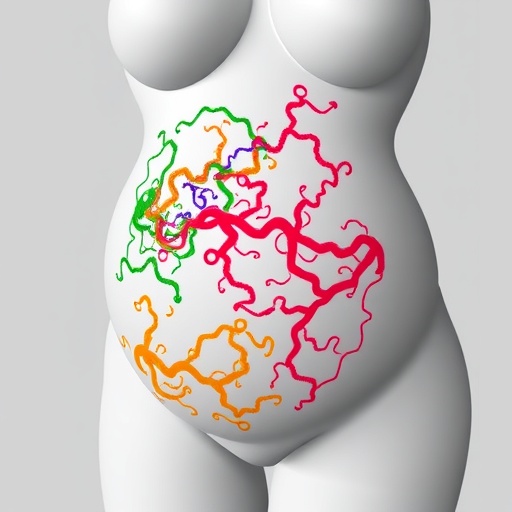In a groundbreaking study, researchers have elucidated a potential breakthrough in women’s reproductive health by identifying distinct urinary exosomal microRNAs that may serve as biomarkers for differentiating premature ovarian insufficiency (POI) from menopause. As women age, they undergo a variety of hormonal changes; however, the specific identification of these changes, particularly when they occur prematurely, has posed a significant challenge to clinicians and researchers alike. The phrase “premature” implies that ovarian failure occurs before the age of 40, marking a critical health concern that affects a woman’s quality of life, fertility, and even long-term health outcomes.
Premature ovarian insufficiency can be a devastating diagnosis for young women who are often unprepared for the consequences of hormonal decline. This condition not only disrupts menstrual cycles but also leads to difficulties in conceiving, making the differentiation between POI and natural menopause key for appropriate intervention. Yet, the diagnostic tools available up until now often fall short of providing a clear distinction. The innovative approach taken by Maham et al. opens up promising avenues for clinical application, which could dramatically alter patient management strategies.
In recent years, the understanding of microRNAs—small non-coding RNA molecules that regulate gene expression—has reached new heights. They have emerged as critical players in various biological processes, including development, differentiation, and responses to stress. Their role in ovarian function has sparked interest in their potential as biomarkers. The research team employed advanced molecular techniques to analyze urinary exosomes, which are nano-sized vesicles secreted by cells and contain valuable genetic material including microRNAs. By investigating these exosomal contents, the team aimed to unveil biomarkers that can provide insights into the ovarian lifecycle.
The study utilized a robust cohort of women diagnosed with POI and those undergoing natural menopause. By comparing the exosomal microRNA profiles between these two distinct groups, the researchers were able to identify specific microRNAs whose expression patterns significantly differed. This finding is pivotal; not only does it provide evidence that unique microRNA signatures are present in urinary exosomes, but it also implies that these molecules may serve as a non-invasive diagnostic tool for clinicians to differentiate between POI and menopause.
MicroRNA profiling has come a long way, as advances in sequencing and analytical technologies have made the identification and quantification of these small RNA molecules more feasible than ever. As a result, the identification of a reliable panel of urinary exosomal microRNAs could revolutionize how we understand and treat conditions leading to reproductive aging. The non-invasive nature of urinary sample collection means that this method could be routinely implemented in clinical settings without the need for invasive procedures typically associated with ovarian assessments.
Moreover, the clinical implications extend beyond mere diagnosis. Understanding the specific pathways and molecular mechanisms involved in POI has the potential to pave the way for targeted therapies tailored to the needs of young women. For instance, if particular microRNAs are associated with the onset of ovarian insufficiency, they could be targeted for therapeutic purposes aimed at preserving ovarian function or mitigating symptoms.
The broader impact of this research cannot be underestimated. The knowledge gained from this study could empower women with information regarding their reproductive health. By providing an accurate diagnosis at an earlier stage, women could make informed decisions about family planning and seek appropriate medical interventions sooner, enhancing their chances of a fulfilling reproductive life.
While the study results are promising, it is crucial to approach the application of these findings with caution. Future research will be essential to validate these microRNA profiles across diverse populations and settings. Additionally, establishing standardized testing protocols will be necessary to ensure that healthcare providers can confidently use this information in clinical practice.
This research also highlights the importance of interdisciplinary collaboration in uncovering novel diagnostic tools. The integration of molecular biology, clinical practice, and bioinformatics brought together diverse expertise, ultimately aiding in the translation of complex scientific concepts into practical healthcare applications. It serves as a reminder that the future of medicine may lie in the synthesis of various scientific disciplines aimed solely at improving health outcomes.
The implications of distinguishing between POI and menopause reach into many facets of a woman’s life, from emotional wellbeing to societal roles and reproductive choices. As such, enhanced understanding through reliable molecular biomarkers may serve as a foundation not only for individual health but also for public health strategies aimed at addressing issues associated with reproductive aging.
As this research gains traction, it undoubtedly opens the door for future studies that could similarly explore other conditions entailing reproductive dysfunction or hormonal imbalances. The field of reproductive health is ripe for innovation, and the advent of liquid biopsy technologies, such as the analysis of urinary exosomes, represents a significant step forward in this direction.
In conclusion, Maham et al.’s exploration of urinary exosomal microRNAs serves as a beacon of hope for those grappling with the impacts of premature ovarian insufficiency. Their findings may hold the key to unlocking personalized medicine approaches in reproductive health, allowing women to reclaim control over their bodies and health decisions. As the scientific community continues to embrace the power of molecular diagnostics, the landscape of women’s health care is poised for much-needed transformation.
The journey from discovery to clinical application is often long and fraught with challenges, but with each piece of research like this one, we get a step closer to realizing a future where women have access to the diagnostics and personalized approaches that their reproductive health necessitates.
Subject of Research: Distinct urinary exosomal microRNAs as biomarkers for differentiating premature ovarian insufficiency and menopause
Article Title: Distinct urinary exosomal microRNAs as biomarkers for differentiating premature ovarian insufficiency and menopause
Article References: Maham, S., Kang, J.H., Kahttana, I. et al. Distinct urinary exosomal microRNAs as biomarkers for differentiating premature ovarian insufficiency and menopause. J Ovarian Res 18, 263 (2025). https://doi.org/10.1186/s13048-025-01823-y
Image Credits: AI Generated
DOI: https://doi.org/10.1186/s13048-025-01823-y
Keywords: microRNAs, urinary exosomes, premature ovarian insufficiency, menopause, biomarkers, reproductive health
Tags: challenges in diagnosing ovarian insufficiencyclinical applications of microRNA researchdifferentiating premature ovarian insufficiencyfertility issues in young womenhormonal changes in womenidentifying menopause vs POIimplications of premature ovarian failurelong-term health outcomes of POImicroRNA biomarkers for ovarian healthreproductive health breakthroughsurinary exosomal microRNAswomen’s health and aging





